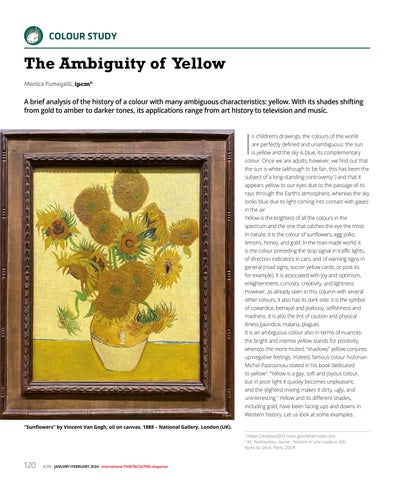COLOUR STUDY
The Ambiguity of Yellow Monica Fumagalli, ipcm®
A brief analysis of the history of a colour with many ambiguous characteristics: yellow. With its shades shifting from gold to amber to darker tones, its applications range from art history to television and music.
I
n children’s drawings, the colours of the world are perfectly defined and unambiguous: the sun is yellow and the sky is blue, its complementary
colour. Once we are adults, however, we find out that the sun is white (although to be fair, this has been the subject of a long-standing controversy1) and that it appears yellow to our eyes due to the passage of its rays through the Earth’s atmosphere, whereas the sky looks blue due to light coming into contact with gases in the air. Yellow is the brightest of all the colours in the spectrum and the one that catches the eye the most. In nature, it is the colour of sunflowers, egg yolks, lemons, honey, and gold. In the man-made world, it is the colour preceding the stop signal in traffic lights, of direction indicators in cars, and of warning signs in general (road signs, soccer yellow cards, or post-its for example). It is associated with joy and optimism, enlightenment, curiosity, creativity, and lightness. However, as already seen in this column with several other colours, it also has its dark side: it is the symbol of cowardice, betrayal and jealousy, selfishness and madness. It is also the tint of caution and physical illness (jaundice, malaria, plague). It is an ambiguous colour also in terms of nuances: the bright and intense yellow stands for positivity, whereas the more muted, “shadowy” yellow conjures up negative feelings. Indeed, famous colour historian Michel Pastoureau stated in his book dedicated to yellow2: “Yellow is a gay, soft and joyous colour, but in poor light it quickly becomes unpleasant, and the slightest mixing makes it dirty, ugly, and uninteresting.” Yellow and its different shades, including gold, have been facing ups and downs in © ipcm
Western history. Let us look at some examples.
“Sunflowers” by Vincent Van Gogh, oil on canvas, 1888 – National Gallery, London (UK). https://eclipse2017.nasa.gov/what-color-sun M. Pastoureau, Jaune : histoire d ‘une couleur, Éditions du Seuil, Paris, 2019 1 2
120
N. 85 - JANUARY/FEBRUARY 2024 - international PAINT&COATING magazine
